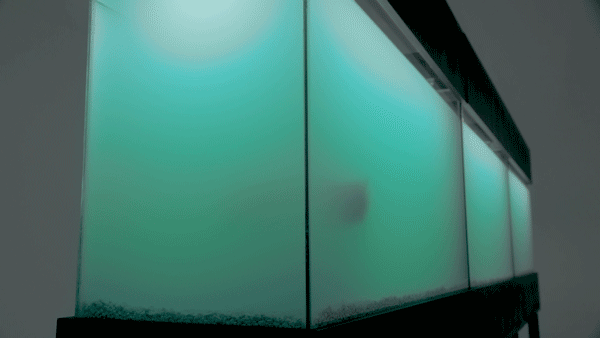In perpetuity
- Karine Payette
Articles
Outrage sur l’animal, Éric Clément, La presse +, édition du 7 avril 2018.

“Visitors go to the zoo to look at the animals. They go from cage to cage, like visitors to an art gallery, stopping in front of each picture before passing on to the next on, and then the next. Except at the zoo, our vision is always distorted. Like an out-of-focus photograph.”
– John Berger, 1980
With In perpetuity, the Montreal artist Karine Payette continues to reflect on the complex relationships that humans have with other species, a project that she began a few years ago. Within her multidisciplinary practice, she combines two illuminating themes: habitat and living. If the domestic universe, living spaces and the incessant quest for comfort(ing) form primary aspects of her approach, this kinetic installation initiates a new body of work that now turns towards artificial environments where animals evolve, such as in zoos, circuses and pet shops.
While fascinated by such places where amazement rubs up against disenchantment, Payette is particularly interested in the compulsive disorders that arise amongst their inhabitants. Enclosures, boredom and proximity to humans have been shown to cause significant stress in animals. The presence of stereotypies, which are abnormal chronic behaviors, signify one of the most obvious signs of what some specialists call “zoochosis” (a term formed by the contraction of zoo and psychosis). These movements are easily noticeable during a visit to the zoo, for example, a feline that roams in its cage, going back and forth along a specific path, or a bear that repeatedly sways in one spot. Conceived from observations in situ and from ethological research, In Perpetuity invites us to enter into an immersive space that seems situated outside of time.
The installation consists of three dark aquariums where unidentified specimens move. The presence of strange animals are veiled and sublimated within the murky turquoise water. Are they aquatic mammals? No one can say for sure. A few moments are enough however, for fascination to give way to perplexity: what appeared at first as familiar forms, instead become troubling presences. Seemingly trapped in a kind of madness, animals perform endless repetitive circles. Payette thus stages a falsified vision that problematizes living creatures in precisely ambiguous ways.
Berger, John, « Why Look at Animals? » (1980), trad. fr. Katia Berger Andreadakis, « Pourquoi regarder les animaux ? », dans John Berger, Au regard du regard, Paris : L’Arche, 1995, pp. 7-35.
– Julia Roberge
Writer Biography
Julia Roberge Van Der Donckt completed her Ph.D. in Art History at the University of Montreal in 2017, where she also taught. Her thesis, entitled What controversy does to works. A three-stage study of controversy in contemporary art traces the development of recent artistic scandals. She is currently conducting research on the use and representation of non-human animals in culture and the visual arts. Author of Towards an antispecial aesthetic ?, published in esse: arts + opinions in 2016, she also directed a special issue “Arts” of Véganes, countercultural magazine, which will appear in autumn 2018.
Artist Biography
Born in 1983, Karine Payette lives and works in Montreal. As a multidisciplinary artist, her work spans installation, photography, and video. She constructs playful, dreamlike large-scale works made from recycled and found objects. Fascinated by the intrinsic connections between identity and habitat, she reflects on the notions of comfort and conflict in our ever-changing world.
Payette’s work has been the focus of several solo exhibitions across Quebec. She has participated in more than twenty collectives in Canada and France. In 2016, her work was shown in a solo exhibition in Germany at Art Mûr Leipzig. Since 2015, Payette has produced three projects integrating art into architecture for Montreal schools. Her work is in several private collections, as well as the Musée d’art contemporain de Baie-Saint-Paul and the Collection Prêt d’œuvres d’art at the Musée national des beaux-arts du Québec.





